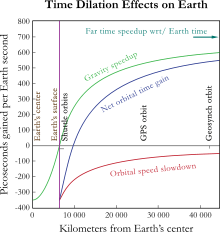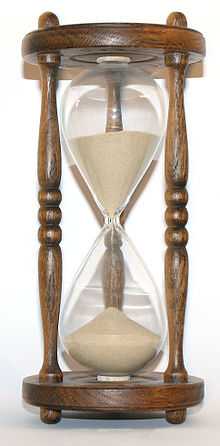Gravitational time dilation
Gravitational time dilation is a form of time dilation, an actual difference of elapsed time between two events as measured by observers situated at varying distances from a gravitating mass. The stronger the gravitational potential (the closer the clock is to the source of gravitation), the slower time passes. Albert Einstein originally predicted this effect in his theory of relativity[1] and it has since been confirmed by tests of general relativity.
This has been demonstrated by noting that atomic clocks at differing altitudes (and thus different gravitational potential) will eventually show different times. The effects detected in such experiments are extremely small, with differences being measured in nanoseconds.
Gravitational time dilation was first described by Albert Einstein in 1907[2] as a consequence of special relativity in accelerated frames of reference. In general relativity, it is considered to be a difference in the passage of proper time at different positions as described by a metric tensor of spacetime. The existence of gravitational time dilation was first confirmed directly by the Pound–Rebka experiment in 1959.
Definition
Clocks that are far from massive bodies (or at higher gravitational potentials) run faster, and clocks close to massive bodies (or at lower gravitational potentials) run slower. This is because gravitational time dilation is manifested in accelerated frames of reference or, by virtue of the equivalence principle, in the gravitational field of massive objects.[3]
According to general relativity, inertial mass and gravitational mass are the same, and all accelerated reference frames (such as a uniformly rotating reference frame with its proper time dilation) are physically equivalent to a gravitational field of the same strength.[4]
Let us consider a family of observers along a straight "vertical" line each of whom experiences a constant g-force along this line (e.g., a long accelerating spacecraft, a skyscraper, a shaft on a planet). Let  be the dependence of g-force on "height", a coordinate along aforementioned line. The equation with respect to a base observer at
be the dependence of g-force on "height", a coordinate along aforementioned line. The equation with respect to a base observer at  is
is
where  is the total time dilation at a distant position
is the total time dilation at a distant position  ,
,  is the dependence of g-force on "height"
is the dependence of g-force on "height"  ,
,  is the speed of light, and
is the speed of light, and  denotes exponentiation by e.
denotes exponentiation by e.
For simplicity, in a Rindler's family of observers in a flat space-time the dependence would be
with constant  , which yields
, which yields
-
 .
.
On the other hand, when  is nearly constant and
is nearly constant and  is much smaller than
is much smaller than  , the linear "weak field" approximation
, the linear "weak field" approximation  may also be used.
may also be used.
See Ehrenfest paradox for application of the same formula to a rotating reference frame in the flat space-time.
Outside a non-rotating sphere
A common equation used to determine gravitational time dilation is derived from the Schwarzschild metric, which describes spacetime in the vicinity of a non-rotating massive spherically symmetric object. The equation is:
where
-
 is the proper time between events A and B for a slow-ticking observer within the gravitational field,
is the proper time between events A and B for a slow-ticking observer within the gravitational field, -
 is the coordinate time between events A and B for a fast-ticking observer at an arbitrarily large distance from the massive object (this assumes the fast-ticking observer is using Schwarzschild coordinates, a coordinate system where a clock at infinite distance from the massive sphere would tick at one second per second of coordinate time, while closer clocks would tick at less than that rate),
is the coordinate time between events A and B for a fast-ticking observer at an arbitrarily large distance from the massive object (this assumes the fast-ticking observer is using Schwarzschild coordinates, a coordinate system where a clock at infinite distance from the massive sphere would tick at one second per second of coordinate time, while closer clocks would tick at less than that rate), -
 is the gravitational constant,
is the gravitational constant, -
 is the mass of the object creating the gravitational field,
is the mass of the object creating the gravitational field, -
 is the radial coordinate of the observer (which is analogous to the classical distance from the center of the object, but is actually a Schwarzschild coordinate),
is the radial coordinate of the observer (which is analogous to the classical distance from the center of the object, but is actually a Schwarzschild coordinate), -
 is the speed of light, and
is the speed of light, and -
 is the Schwarzschild radius of
is the Schwarzschild radius of  .
.
To illustrate then, without accounting for the effects of rotation, proximity to the Earth's gravitational well will cause a clock on the planet's surface to accumulate around 0.0219 fewer seconds over a period of one year than would a distant observer's clock. In comparison, a clock on the surface of the sun will accumulate around 66.4 fewer seconds in one year.
Circular orbits
In the Schwarzschild metric, free-falling objects can be in circular orbits if the orbital radius is larger than  . The formula for a clock at rest is given above; for a clock in a circular orbit, the formula is instead.
. The formula for a clock at rest is given above; for a clock in a circular orbit, the formula is instead.
Important features of gravitational time dilation
- According to the general theory of relativity, gravitational time dilation is copresent with the existence of an accelerated reference frame. Additionally, all physical phenomena in similar circumstances undergo time dilation equally according to the equivalence principle used in the general theory of relativity.
- The speed of light in a locale is always equal to c according to the observer who is there. That is, every infinitesimal region of space time may be assigned its own proper time and the speed of light according to the proper time at that region is always c. This is the case whether or not a given region is occupied by an observer. A time delay is measured for signals that bend near the Sun, headed towards Venus, and bounce back to Earth along a more or less similar path. There is no violation of the speed of light in the sense above, as any observer observing the speed of photons in their region find the speed of those photons to be c, while the speed that it takes light to travel the finite distance past the Sun will differ from c.
- If an observer is able to track the light in a remote, distant locale which intercepts a remote, time dilated observer nearer to a more massive body, that first observer tracks that both the remote light and that remote time dilated observer have a slower time clock than other light which is coming to the first observer at c, like all other light the first observer really can observe (at their own location). If the other, remote light eventually intercepts the first observer, it too will be measured at c by the first observer.
Experimental confirmation

Gravitational time dilation has been experimentally measured using atomic clocks on airplanes. The clocks aboard the airplanes were slightly faster with respect to clocks on the ground. The effect is significant enough that the Global Positioning System's artificial satellites need to have their clocks corrected.[5]
Additionally, time dilations due to height differences of less than 1 meter have been experimentally verified in the laboratory.[6]
Gravitational time dilation has also been confirmed by the Pound–Rebka experiment, observations of the spectra of the white dwarf Sirius B and experiments with time signals sent to and from Viking 1 Mars lander.
See also
References
- ↑
- A. Einstein, "Relativity : the Special and General Theory by Albert Einstein."Project Gutenberg. <https://www.gutenberg.org/etext/5001.>
- ↑ A. Einstein, "Über das Relativitätsprinzip und die aus demselben gezogenen Folgerungen", Jahrbuch der Radioaktivität und Elektronik 4, 411–462 (1907); English translation, in "On the relativity principle and the conclusions drawn from it", in "The Collected Papers", v.2, 433–484 (1989); also in H M Schwartz, "Einstein's comprehensive 1907 essay on relativity, part I", American Journal of Physics vol.45,no.6 (1977) pp.512–517; Part II in American Journal of Physics vol.45 no.9 (1977), pp.811–817; Part III in American Journal of Physics vol.45 no.10 (1977), pp.899–902, see parts I, II and III.
- ↑ John A. Auping, Proceedings of the International Conference on Two Cosmological Models, Plaza y Valdes, ISBN 6074025304, 9786074025309
- ↑ Johan F Prins, On Einstein's Non-Simultaneity, Length-Contraction and Time-Dilation
- ↑ Richard Wolfson (2003). Simply Einstein. W W Norton & Co. p. 216. ISBN 0-393-05154-4.
- ↑ C. W. Chou*, D. B. Hume, T. Rosenband and D. J. Wineland; Optical Clocks and Relativity; Science vol 329 no. 5999 (24 September 2010), pp. 1630–1633;
External links
| |||||||||||||||||||||||||||||||||||||||||||||||||||||||||||||||||
| ||||||||||||||||||||||||||||||||||||||||||
![T_d(h) = \exp\left[\frac{1}{c^2}\int_0^h g(h') dh'\right]](../I/m/71655a7f368b1a8059d53388217be04c.png)



